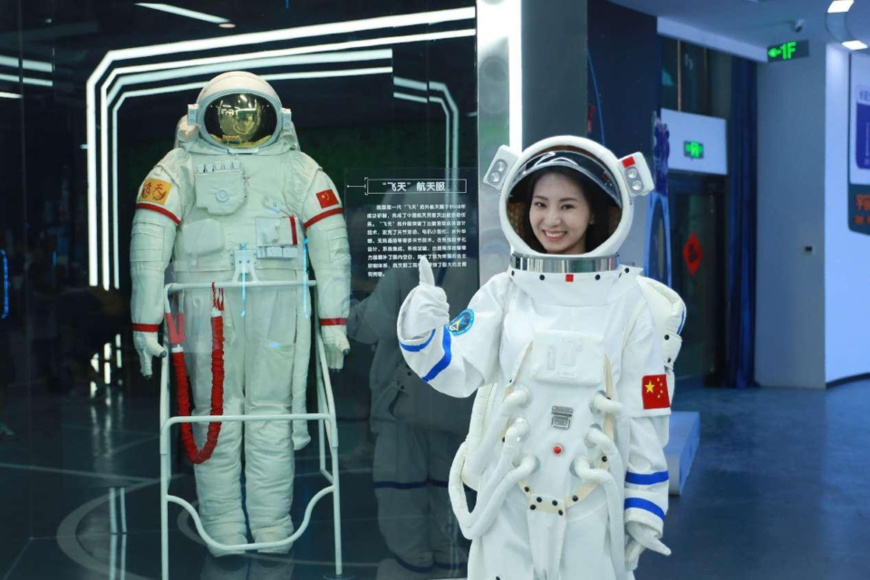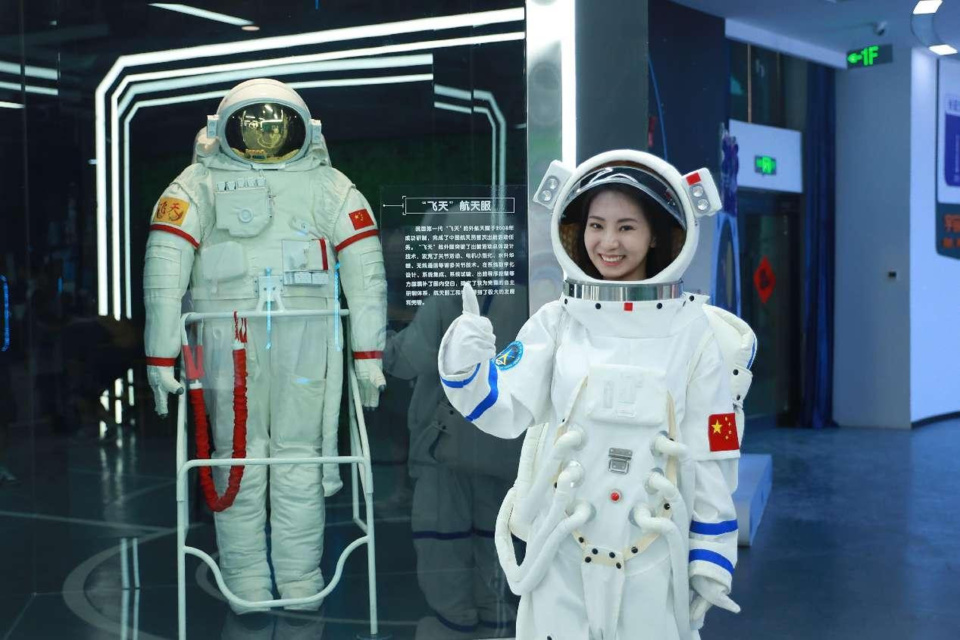By Liu Shiyao, People's Daily

A woman poses for a picture in a spacesuit model in a space science museum in Jiuquan, northwest China's Gansu province. (Photo by Chen Kun/People's Daily Online)
As one of the two operational space stations in the world, the Chinese space station Tiangong weighs over 100 tons and offers more than 100 cubic meters of living and working space, showcasing superior technology worldwide.
"Every small step forward brings us closer to our aspirations. The Chinese space station is always worth looking forward to!" This was the heartfelt exclamation made by Chinese astronaut Liu Yang on September 2, 2022, upon completing her first spacewalk during the Shenzhou-14 mission.
In 2012, Liu made her first journey to space aboard the Shenzhou-9 spacecraft. As she left the Tiangong-1 experimental space lab, she made a wish: "I will definitely come back." Ten years later, Liu realized her dream of "flying to the heavens" once again.
During the Shenzhou-14 mission, Liu and other crew members welcomed the arrival of two lab modules, Wentian and Mengtian. The two modules, together with the Tianhe core module, formed the space station's basic configuration in T shape, demonstrating the ingenious design of the Chinese space station.
Nie Haisheng, another Chinese astronaut who was tasked with three of China's pioneering spaceflights, has gained new insights and experiences each time. He said that the Chinese space station is continuously enhancing comfort, increasing reliability, expanding living space, and diversifying space food.
"Upon entering the space station, my first impression was how spacious it felt, with a real sense of depth," said astronaut Tang Hongbo.
"My second impression was how quiet the sleeping area was, with very little noise. The third one was that this was truly a 'room with a view,'" Tang added.
"When I was off work, I would always grab my phone and snap pictures of the stunning scenery outside the window. It's also a unique opportunity to conduct experiments and get firsthand experiences there," Tang said.
China's manned space program has always aimed for world-class standards, working toward major breakthroughs in key technologies. China has tackled critical technological challenges in space exploration, including space transportation, space extravehicular activity, and space docking. It has independently developed a unique space station robotic arm system that meets mission requirements. All components and core elements are manufactured by China.
Starting with the launch of the Tianhe core module in April 2021, China completed the comprehensive construction of its space station in less than 20 months, setting a world record for the fastest space station assembly.
China's manned space program has completed what took developed countries half a century in just 30 years, from unmanned flights to manned missions, from single-day solo flights to multi-person extended stays, from in-cabin experiments to extravehicular activities, and from single spacecraft flights to the space station orbiting the Earth.
Behind these achievements lie the collaborative efforts of over 110 research institutes, more than 3,000 scientific research units, and hundreds of thousands of researchers, all working together to drive China's advancements in space.
Equally eye-catching are the applications of space technologies across different industries.
In 2016, during the Shenzhou-11 mission, China cultivated vegetables in space for the first time. Astronaut Jing Haipeng wrote in his diary: "At that time, my fellow crew member Chen Dong and I were both thrilled. We immediately shared this good news with the ground staff. We took many photos and even posed for pictures with the lettuce sprouts."
Six years later, Chinese astronauts celebrated the Mid-Autumn Festival in space for the first time, enjoying fresh lettuce they had grown themselves. "The taste was fantastic," said astronaut Cai Xuzhe.
The primary objective of building spacecraft and space stations is to apply research advancements. In these Chinese national space laboratories, various experiments are underway, with an increasing number of applications successfully transferred and adapted.
For instance, Chinese space breeding has helped increase annual grain production by about 2.6 billion kilograms, showcasing improved crop yields from rice seeds sent to space, along with high praise for space-grown cucumbers and tomatoes.
Besides, the technologies created for astronauts living in orbit, including devices to prevent bone loss, can also be used to prevent degenerative osteoporosis and muscle atrophy.
As of August 2023, over 100 space science research and application projects had been implemented on the Chinese space station, and more than 4,000 space application achievements had been widely used across different industries.
From the BeiDou Navigation Satellite System to the Chang'e series lunar probes, and from the Tianwen Mars exploration missions to the Xihe solar exploration satellite, China has significantly strengthened its space technology and expanded the scope of space exploration.
Chinese space explorers will keep writing magnificent chapters in the vast universe, contributing to the realization of the Chinese dream.
"Every small step forward brings us closer to our aspirations. The Chinese space station is always worth looking forward to!" This was the heartfelt exclamation made by Chinese astronaut Liu Yang on September 2, 2022, upon completing her first spacewalk during the Shenzhou-14 mission.
In 2012, Liu made her first journey to space aboard the Shenzhou-9 spacecraft. As she left the Tiangong-1 experimental space lab, she made a wish: "I will definitely come back." Ten years later, Liu realized her dream of "flying to the heavens" once again.
During the Shenzhou-14 mission, Liu and other crew members welcomed the arrival of two lab modules, Wentian and Mengtian. The two modules, together with the Tianhe core module, formed the space station's basic configuration in T shape, demonstrating the ingenious design of the Chinese space station.
Nie Haisheng, another Chinese astronaut who was tasked with three of China's pioneering spaceflights, has gained new insights and experiences each time. He said that the Chinese space station is continuously enhancing comfort, increasing reliability, expanding living space, and diversifying space food.
"Upon entering the space station, my first impression was how spacious it felt, with a real sense of depth," said astronaut Tang Hongbo.
"My second impression was how quiet the sleeping area was, with very little noise. The third one was that this was truly a 'room with a view,'" Tang added.
"When I was off work, I would always grab my phone and snap pictures of the stunning scenery outside the window. It's also a unique opportunity to conduct experiments and get firsthand experiences there," Tang said.
China's manned space program has always aimed for world-class standards, working toward major breakthroughs in key technologies. China has tackled critical technological challenges in space exploration, including space transportation, space extravehicular activity, and space docking. It has independently developed a unique space station robotic arm system that meets mission requirements. All components and core elements are manufactured by China.
Starting with the launch of the Tianhe core module in April 2021, China completed the comprehensive construction of its space station in less than 20 months, setting a world record for the fastest space station assembly.
China's manned space program has completed what took developed countries half a century in just 30 years, from unmanned flights to manned missions, from single-day solo flights to multi-person extended stays, from in-cabin experiments to extravehicular activities, and from single spacecraft flights to the space station orbiting the Earth.
Behind these achievements lie the collaborative efforts of over 110 research institutes, more than 3,000 scientific research units, and hundreds of thousands of researchers, all working together to drive China's advancements in space.
Equally eye-catching are the applications of space technologies across different industries.
In 2016, during the Shenzhou-11 mission, China cultivated vegetables in space for the first time. Astronaut Jing Haipeng wrote in his diary: "At that time, my fellow crew member Chen Dong and I were both thrilled. We immediately shared this good news with the ground staff. We took many photos and even posed for pictures with the lettuce sprouts."
Six years later, Chinese astronauts celebrated the Mid-Autumn Festival in space for the first time, enjoying fresh lettuce they had grown themselves. "The taste was fantastic," said astronaut Cai Xuzhe.
The primary objective of building spacecraft and space stations is to apply research advancements. In these Chinese national space laboratories, various experiments are underway, with an increasing number of applications successfully transferred and adapted.
For instance, Chinese space breeding has helped increase annual grain production by about 2.6 billion kilograms, showcasing improved crop yields from rice seeds sent to space, along with high praise for space-grown cucumbers and tomatoes.
Besides, the technologies created for astronauts living in orbit, including devices to prevent bone loss, can also be used to prevent degenerative osteoporosis and muscle atrophy.
As of August 2023, over 100 space science research and application projects had been implemented on the Chinese space station, and more than 4,000 space application achievements had been widely used across different industries.
From the BeiDou Navigation Satellite System to the Chang'e series lunar probes, and from the Tianwen Mars exploration missions to the Xihe solar exploration satellite, China has significantly strengthened its space technology and expanded the scope of space exploration.
Chinese space explorers will keep writing magnificent chapters in the vast universe, contributing to the realization of the Chinese dream.
 Menu
Menu
 China keeps advancing space exploration technology
China keeps advancing space exploration technology
















